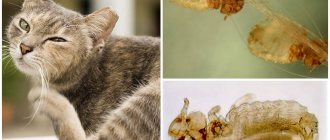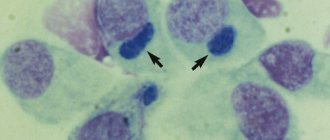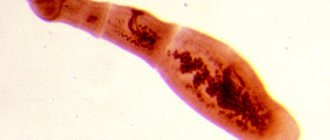Signs of roundworms, methods of deworming
The most common cat parasite is roundworms. The whitish worms reproduce in the intestines and can reach 13 centimeters. They usually come out in excrement, with sputum when coughing. If cats have worms:
- loose stools are observed;
- cough appears;
- eyes become dim;
- wool loses its shine;
- Appetite increases greatly.
The kitten's belly may become bloated.
The main means of combating worms are drugs made on the basis of piperazine. The dosage is selected taking into account the weight of the animal and its age. It is necessary to strictly observe hygiene rules and carry out regular preventive measures. Anti-worm medications should be given once a year. Deworming includes 2 procedures with an interval of 10 days.
It is impossible to remove roundworms from a sick animal. In this condition, medications containing piperazine are deadly for your pet. Pregnant and lactating cats are not dewormed.
Hookworms and tapeworms
Hookworms, which suck blood from the vessels located in the intestinal walls, pose a particular danger to cats. This leads to anemia. Most of these parasites are found in the United States. In other countries they are extremely rare.
Tapeworms can settle in parts of the intestines. This is a type of tapeworm. The head of the parasite is attached to the intestinal wall. The eggs mature in the terminal segment, which falls off and comes out with excrement. If tapeworms are present, small white grains can be seen on the hairs in the anal area. They may still be alive and moving. It is easier to notice segments with eggs on dark fur.
Tapeworms enter the animal's body in various ways. If a cat hunts or walks outside, parasites can come from mice and rats. Fleas can bring them to pets. In veterinary pharmaceuticals there are special drugs that destroy tapeworms. They should also be used as a preventive measure if the cat has free access to the street and is an avid hunter. The dosage of the drugs must be determined by a veterinarian.
Scientists: cat parasite enslaves people, making them servants of four-legged pets
Russian Look
ALL PHOTOS
Scientists: cat parasite enslaves people, making them servants of four-legged pets Russian Look
Previously, it was only about mice and rats that the parasite pushed into the cat's teeth, but now there is a suspicion that the crazy love experienced by some people for their four-legged pets may also be explained by a parasitic infection Global Look Press
A new study examining the characteristics of the parasite Toxoplasma gondii, which reproduces in the body of cats, has once again confirmed that this animal becomes attractive in the eyes of an infected creature Global Look Press
A new study examining the characteristics of the parasite Toxoplasma gondii, which multiplies in the body of cats, has once again confirmed that this animal becomes attractive in the eyes of an infected creature. Previously, we were talking only about mice and rats, which the parasite pushed into the cat’s teeth, but now there is a suspicion that the crazy love experienced by some people for their four-legged pets may also be explained by a parasitic infection.
“Do you love cats because they are beautiful, graceful creatures? Or is it because you are infected with a parasite that affects the brain?” asks Time magazine. Studies conducted in past years have already established that Toxoplasma gondii, when entering the human body, can affect personality traits and even create a threat of schizophrenia and paranoia. These data were confirmed by new analyzes.
The causative agent of toxoplasmosis, the single-celled parasite Toxoplasma gondii, does not usually have a serious impact on human health, but some groups of the population are more vulnerable to the disease. For example, toxoplasmosis during pregnancy can lead to developmental disorders of the fetus. The parasite can also be dangerous for people with weakened immune systems, for example, for people with AIDS, InoPressa reports.
Studies published in 2003 and 2007 confirmed the dependence of the manifestations of schizophrenia and paranoia on the presence of Toxoplasma gondii. Acute Toxoplasma infection has been found to sometimes lead to psychotic symptoms not different from schizophrenia. Scientists also found that Toxoplasma infection leads to damage to astrocytes in the brain, while similar damage to astrocytes is observed in schizophrenia. According to observations, the behavior of people infected with toxoplasma changes. Carriers of the infection are characterized by slow reactions, constant feelings of anxiety, and neurotic manifestations.
According to statistics, more than half of the world's population is infected with toxoplasmosis. The highest rates of infection are observed in Brazil, France and Germany. The fewest people affected by the parasite are in the UK and South Korea.
The parasite is transmitted to humans through contact with raw or undercooked meat, especially pork. A cat owner can become infected by handling feces while changing the litter box.
Infected rodents become sexually aroused after smelling cat urine
The parasite lives in the body of almost all mammals, but its reproduction is possible only in the body of felines. It is for this reason that the parasite makes the cat attractive to its potential victims - rats and mice. By eating prey, the cat becomes infected, and the parasite achieves its goal by successfully reproducing.
Four years ago, researchers from the American Stanford University in California, having studied the effect of Toxoplasma on rats and mice, found that the parasite zombies the victim by interfering with the work of the cerebellar amygdala and changing the set of conditioned reactions in the brain. At the same time, the innate fear of cats in rodents disappeared - the infected animals began to like the smell of cat urine, and they rushed towards danger.
Scientists at Stanford's Patrick House conducted a new study on rats' reactions to cat urine. This time it was discovered that in rodents infected with Toxoplasma gondii, when they were near the urine of their main enemy, the parts of the brain responsible for sexual arousal were activated.
Cat fleas
Most often, cat owners have to look for ways to control fleas. These insects feed on blood and can bite a dog or a person, but they prefer to breed on representatives of the cat family. The most attractive areas for them are the chest and back. If there are too many fleas, eczema, anemia, and other diseases can begin. The main symptoms are:
- restless behavior;
- the appearance of graininess on the skin;
- continuous carding.
The modern assortment includes many insecticides that provide effective control of insects. The products are available in the form of liquids, powders, and sprays. Collars with anti-flea impregnation are available for sale. The convenience of such an accessory is undeniable. But some products have an odor that is too intense for the animal to tolerate. In addition, cats often take off their collar. It is better to use such accessories as a preventive measure if the cat tolerates it calmly.
Aerosols, drops, and special powder can be used to kill fleas. It is important to strictly follow the instructions for use. If the infection is severe, it is necessary to use a bathing procedure with a special shampoo. After washing, the wool must be rinsed thoroughly. If insecticide enters the body, it can lead to severe poisoning.
It should be noted that fleas can reproduce not only on the cat’s body. You need to treat upholstered furniture that your pet often sits on and its bedding. For this procedure, you can use ordinary household chemicals with insecticides. But before treatment, the animal must be removed from the premises. You can get rid of fleas in the house with the aromas of coniferous trees and wormwood.
In addition to fleas, cats can also get lice. They are distinguished by a light gray color and are also blood-sucking. Treatment methods for lice and fleas are similar. But you will have to repeat the processing several times. The coat must be combed thoroughly to remove nits.
Parasites in the blood of cats
Blood parasites in cats or blood parasites are microorganisms (protozoa, bacteria, rickettsia) or worms (trematodes, nematodes) that live in the blood and/or lymph of the host and cause similar symptoms (fever, anemia, etc.).
Depending on the type, blood parasites of cats are localized:
— Inside red blood cells (rickettsia, babesia (pyroplasma))
— On the surface of red blood cells (trypanosomes)
— In leukocytes and lymph (theileria, hepatozoons, rickettsia)
— In blood plasma (worms)
— In histiocytes (cytozoon, Francisella, Coxiella)
Most cat blood parasites are carried by blood-sucking insects (fleas, mosquitoes), ticks, leeches, etc. However, infection through mechanical contact and food (including accidental ingestion of an infected tick) is also possible.
In this article we will talk about blood parasites-microorganisms; You can read about worms living in the circulatory system of cats in our other articles.
Parasites in the blood of cats: types
| Disease | Parasite | Infection | Symptoms | Spreading | Comments |
| Anaplasmosis | Anoplasma phagocytophillum | Tick bite (brown dog tick, Amblyomma americana, ixodid ticks) (infecting a person directly from a cat is impossible) | fever, loss of appetite, conjunctivitis, lethargy | North America, Europe, Russia, China | Rarely diagnosed in cats |
| Bacillary angiomatosis* | Bartonella henselae | Flea or tick bite (a person becomes infected by being bitten or scratched by an infected cat) | asymptomatic | The whole world | Cats are carriers of the disease People with severely weakened immune systems (HIV-infected) get sick. |
| Flea typhus* | Rickettsia felis | Flea bite (infecting a person directly from a cat is impossible) | asymptomatic | Southern Europe, North and South America, Thailand, Australia | Cats are carriers of the disease |
| Ricketysia typhi | Flea feces getting into wounds on the skin when scratching (infecting a person directly from a cat is impossible) | ||||
| Hemobartonellosis | Haemobartanella felis (hemobartonella)\Mycoplasma haemofelis (hemoplasm) | Bites from infected ticks (taiga, dog, brown dog) and fleas; bites from infected animals; in utero; during blood transfusion (the person is not sick) | weakness, loss of appetite, weight loss, pale mucous membranes, rapid breathing and heartbeat, jaundice, anemia, brown urine, intoxication, death | The whole world | Only 25% of infected cats develop severe disease. Of these, 25% of animals die if left untreated. |
| Mycoplasma haemominutum (hemoplasm) | |||||
| Hepatozoonosis | Hepatozoon felis | Accidental ingestion of a tick (the person is not sick) | weight loss, fever, enlarged spleen and lymph nodes, anemia, lameness, paralysis, death | India, Israel | The disease most often occurs in a latent form and is dangerous only for older cats, kittens and cats with reduced immunity (leukemia, feline immunodeficiency virus, etc.) |
| Coxiellosis (Q fever)* | Coxiella burnetti | Eating contaminated meat/milk, inhaling small contaminated particles of feces/urine/fur, etc., tick/flea bite (a person can become infected by inhaling contaminated particles, especially dangerous after lambing) | fever, weight loss, lethargy, incoordination, miscarriage | The whole world | |
| Cat scratch disease* | Bartonella henselae | Flea bite (a person becomes infected by being bitten or scratched by an infected cat) | asymptomatic | The whole world | Cats are carriers of the disease |
| Bartonella clarridgeiae | |||||
| Leishmaniasis | Leishmania aethiopica | Mosquito bite | Weight loss, fatigue, brittle and dull coat; crusts, nodules and sores around the nose, eyes, ears and on the shoulders; inflammation of the eyes, intermittent fever, nosebleeds, hardening of the lymph nodes, enlargement of the liver and spleen, tumors on the internal organs, impaired coordination of movements, loss of voice, resorption of bone tissue | North Africa | Mostly dogs and rodents are affected; cases of the disease in cats are rare. In Russia, with the exception of the subtropical zone, it is not found due to the lack of mosquitoes carrying Leishmania. |
| Leishmania braziliensis | Bolivia, Brazil, Peru, Northwest China | ||||
| Leishmania donovani | Southern Russia, Southern Europe, Central Asia, China, India, Nepal, Africa, South America | ||||
| Leishmania infantum | |||||
| Leishmania major | North Africa, Middle East, Iran, Afghanistan, Tajikistan, Northwest China and India | ||||
| Leishmania mexicana | South and Central America | ||||
| Leishmania tropica | North Africa | ||||
| Marseille fever | Rickettsia conorii | Tick bite (brown dog) (infecting a person directly from a cat is impossible) | asymptomatic | Mediterranean, Astrakhan region | Cats are carriers of the disease |
| Piroplasmosis (babesiosis) | Babesia felis | Tick bite (hedgehog, meadow, pasture, brown and yellow dog, red sheep) (the person is not sick) | weakness, somnambulism, brown urine, yellow/orange feces, constipation, jaundice, enlarged spleen | USA, Mediterranean, India, South Africa | Several controversial cases of the disease have been recorded in Russia |
| Rocky Mountain Spotted Fever* | Rickettsia Rickettsii | Tick bite (Rocky Mountain wood tick, American dog tick) (infecting a person directly from a cat is impossible) | asymptomatic | USA, Canada, Brazil, Colombia | Cats are carriers of the disease |
| Surra | Trypanosoma evansi | Bite of horsefly (tabanus), burner fly, blood-sucking bat (the person is not sick) | fever, lacrimation, weakness, weight loss, abortion, anemia, death | South America, North Africa, Middle East | |
| Theileriosis (cytozoonosis) | Theileria felis\cytauxzoon felis | Tick bite (American canine, canine, meadow, pasture, American canine, brown canine) (the person is not sick) | anorexia, depression, dehydration, anemia, jaundice, fever, death | North America and South America, Southern Europe | |
| Tularemia | Francisella tularensis | Tick bite (most types)\horsefly\flies, eating contaminated meat\water, inhalation\contamination of bacteria on mucous membranes\damaged skin (a person becomes infected by being bitten or scratched by an infected cat) | lethargy, loss of weight and appetite, ulcers on the tongue, jaundice, fever, enlarged liver, spleen and lymph nodes; dehydration, death | Northern Europe, Russia, USA, Japan | An extremely dangerous and contagious disease |
| American trypanosomiasis (Chagas disease) | Trypanosoma cruzi | Triatomine bug bite (infection directly from a cat is impossible) | weakness, anemia, enlarged spleen and lymph nodes | South and Central America | Most often asymptomatic |
| African animal trypanosomiasis (nagana) | Trypansoma brucei brucei | Tsetse fly bite (infecting a person directly from a cat is impossible) | fever, weakness, weight loss, anemia, paralysis, meningoencephalitis, death | West Africa, South America | |
| Trypanasoma congolese | |||||
| Trypanosoma vivax | |||||
| Ehrlichiosis | Ehrlichia canis | Tick bite (meadow, pasture, brown dog, bush) (infecting a person directly from a cat is impossible) | asymptomatic | USA, South America, Asia, Africa | Bacteria have been found in the blood of cats, but ehrlichiosis is not diagnosed in cats |
Note:
*Diseases related to rickettsiosis
0
Coccidia and toxoplasma
Coccidia are single-celled parasites that penetrate the epithelial surface. They multiply directly in tissue cells, which leads to their destruction. A cat becomes infected from other individuals carrying the pathogen. When coccidia appear:
- there is regular diarrhea;
- blood appears in the feces;
- weight is lost and exhaustion sets in.
Veterinarians have drugs in their arsenal that destroy these parasites. It is important to strictly follow hygiene rules and destroy cat litter by burning it.
A special type of coccidia is Toxoplasma. These parasites destroy the tissue of the visual organs, lymph nodes, and brain. For cats, this type of parasite is considered natural; in small quantities they do not threaten the animal’s body. But infection with toxoplasma is extremely dangerous for pregnant women. These parasites can cause abnormalities in the fetus.










